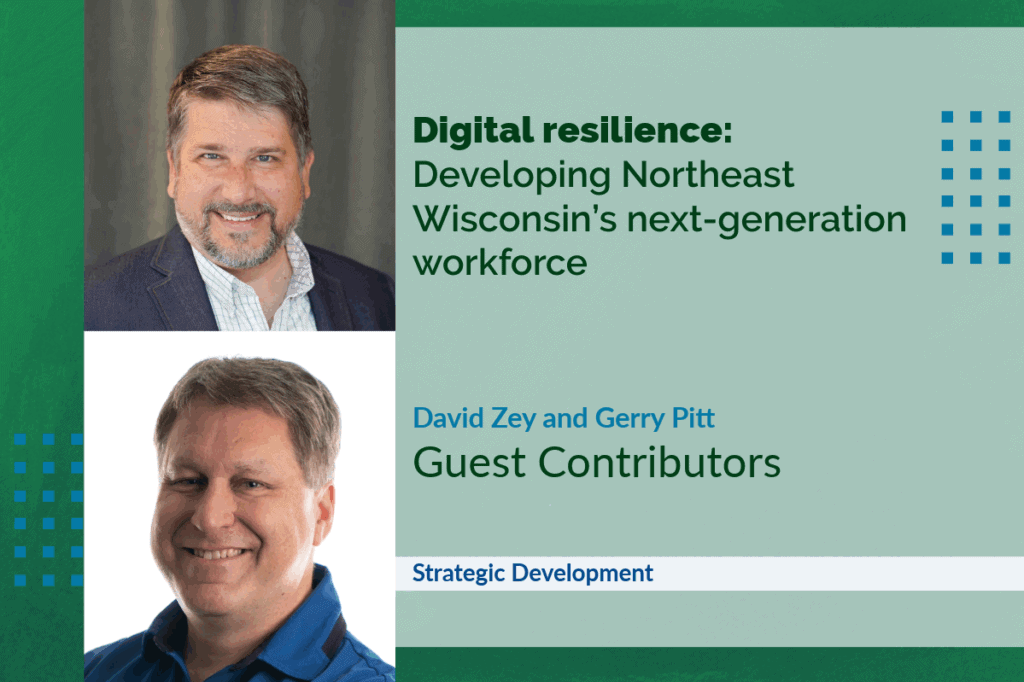
June 30, 2025
In today’s rapidly evolving digital economy, social media has become a dominant force shaping the attitudes, behaviors, and mental frameworks of young people.
What was once a space for personal expression and peer engagement is now one of the most influential ecosystems affecting how youth learn, think and define their identities.
In Northeast Wisconsin – a region rooted in community values and known for cultivating strong work ethics – this cultural shift is redefining what it means to prepare the next generation for the workforce.
Digital resilience is no longer a fringe concept.
It is central to ensuring that the region’s youth are not just safe online, but capable, confident and ready to contribute meaningfully to society and the economy.
Though families, educators and policymakers have traditionally emphasized safety, the conversation must now include strategic investments in digital maturity as a core component of workforce development.
Understanding today’s digital youth
Today’s students are growing up fully immersed in technology.
More than 90% of U.S. teens report using social media daily, with many engaging as early as age 10.
In Northeast Wisconsin – where suburban and rural communities blend – access to smartphones, tablets and internet connectivity is widespread.
Schools integrate technology into classrooms and digital interactions often replace or augment in-person socialization.
Yet, while the internet provides unprecedented access to information, collaboration and creative tools, it also presents new challenges.
The line between enrichment and dependency is increasingly blurred.
Many teens spend upward of three hours per day on social platforms, often without guidance or meaningful oversight.
This level of unstructured digital engagement influences behavior, cognition and emotional development.
These factors can directly affect employability, learning retention and leadership potential.
The implications are clear: The digital habits formed today will impact not only personal development but also future workplace performance.
Risks that undermine workforce readiness
Behind every social media app lies a business model designed to monetize attention and behavior.
These platforms use algorithms that reward impulsiveness, amplify extremes and encourage comparison.
Though they may entertain, they also risk altering the developmental trajectory of youth in ways that compromise resilience and workforce potential.
Here are five major risks communities should understand:
Mental health strain
A growing body of research connects prolonged social media use with increased anxiety, depression and self-esteem issues.
The constant exposure to curated, idealized images fosters unrealistic expectations and emotional fragility.
In a business context, this can translate to lower confidence, decreased initiative and poor stress tolerance among future employees.
Cognitive overload without physical outlet
When young people face digital stress – whether from peer pressure, academic demands or viral trends – they can often lack healthy mechanisms to decompress.
Unlike traditional stressors, digital tension doesn’t culminate in physical exertion or emotional resolution.
Instead, youth may retreat further into passive digital consumption, leading to disengagement and emotional numbness – traits contradictory to effective team participation and leadership.
Exposure to inappropriate content:
Algorithms are designed to boost engagement, not safeguard values.
Even when settings are marked for “child” or “teen,” sensational or mature content often reaches younger users.
This exposure may shape attitudes about relationships, conflict and morality in ways that conflict with professional norms and community expectations.
Cyberbullying, online conflict
Digital harassment – whether through exclusion, ridicule or hostile messages – can create long-lasting psychological wounds.
Youth affected by cyberbullying may develop deep-seated distrust or emotional reactivity that carries into academic, social and professional relationships.
Privacy erosion, oversharing
Many of our youth do not understand the permanence of digital footprints.
A single impulsive post could jeopardize college admissions, scholarship opportunities or job offers.
Teaching digital reputation management is now as important as resume building.
Reframing digital readiness
Too often, the discussion around social media focuses on fear and restriction.
Though protective measures have their place, they should be accompanied by proactive strategies to equip young people with the skills to thrive.
Digital readiness is not just about avoiding harm – it’s about developing competencies, like the following, that will serve youth throughout their careers.
Critical thinking
Can a teen distinguish between reliable information and misinformation?
Are they able to question the credibility of influencers or decode visual manipulation?
These abilities are fundamental for navigating both online environments and complex work projects.
Emotional regulation
Can a young adult manage the highs and lows of digital interaction without overreacting or withdrawing?
Emotional control is key in fast-paced workplaces, where feedback, deadlines and collaboration demand maturity.
Digital communication
Can students write, speak and interact in ways that reflect professionalism and clarity?
Social media language does not always translate well into work settings.
Formal tone, persuasive writing and context-appropriate responses are essential career skills.
This isn’t an attempt to change or suppress a generation’s speech, but rather to encourage flexibility and adapting communication styles across workforce generations.
Decision-making
Are teens learning how to weigh consequences before posting, replying or sharing content?
The same decision-making muscle applies to budgeting, project planning and ethical dilemmas in the workforce.
These skills are not “extra credit.”
They are foundational.
Digital maturity is as critical to career readiness as technical training or academic achievement.
Aligning policy with workforce outcomes
Recognizing the urgency of the issue, Wisconsin has taken significant steps to regulate online environments for youth.
The Kids Online Safety Act, introduced by State Rep. David Steffen (R-Howard), represents a pivotal shift toward accountability in the tech sector.
Key components of the act include:
- Mandatory parental controls to monitor and manage online engagement
- Transparency from platforms about how algorithms influence content exposure
- Proactive moderation of harmful or inappropriate material
This legislation, which passed in 2024, sends a strong signal: Protecting youth online is not only a family responsibility, it is a public interest and an economic necessity.
Northeast Wisconsin, by advocating for this kind of policy, is positioning itself as a leader in safeguarding not just children but the region’s future talent pool.
Collaborating for long-term impact
Beyond policy, local institutions are stepping up.
Schools, nonprofits, law enforcement and civic organizations are launching programs that reframe social media safety as a community-wide workforce development initiative.
School systems are embedding digital citizenship into curricula, focusing on topics like cyberethics, online identity and data privacy.
These efforts promote self-regulation and ethical behavior, essential for professional development.
Public libraries are offering youth-led workshops on online awareness, digital storytelling and content creation that help young people shift from passive consumers to thoughtful creators.
Police departments collaborate with schools to deliver practical education on digital red flags, grooming behavior and reporting protocols – building awareness that translates into personal responsibility.
Faith-based and cultural organizations emphasize value-based digital engagement, reinforcing respect, dignity and purpose as guiding principles.
Youth centers and mentorship programs use social media literacy as a gateway to career coaching, leadership training and goal setting.
These initiatives build more than safety.
They build identity, purpose and pathways.
Why business leaders should care
Though schools and families are on the front lines, the business community needs to recognize its role.
Whether hiring interns, sponsoring events or designing future workforce strategies, companies have a vested interest in youth digital development.
Here’s why:
Talent readiness
Soft skills, maturity and resilience are the differentiators in a competitive labor market.
Businesses can influence curriculum development, mentor programs and sponsor workshops that reinforce these values.
Brand reputation
Companies that invest in youth programs build credibility and community trust, factors that influence consumer loyalty and recruitment appeal.
Innovation pipelines
Young people fluent in both technology and values are ideal candidates for roles in customer service, innovation and leadership.
By helping youth understand responsible tech use, businesses are cultivating their future innovators and managers.
Public-private partnerships
Aligning corporate social responsibility (CSR) initiatives with school-based digital maturity programs amplifies impact and supports regional economic goals.
Tools, resources
A range of practical tools and adaptable resources are available for educators, families and community leaders to support this important shift toward digital responsibility and safety:
Safe Kids Wisconsin toolkit
Includes guides for creating tech agreements, recognizing online red flags and starting meaningful conversations.
Parental control platforms
Tools like Bark and Qustodio are not just for families – they can be introduced in school and community programs to demonstrate healthy boundaries.
Google’s Be Internet Awesome
This gamified learning platform builds core competencies like discernment, password safety and anti-cyberbullying practices.
It’s easily adaptable to classrooms and youth programs.
Custom workforce readiness modules
Schools and employers can collaborate to develop content that ties digital responsibility directly to career pathways, such as “Digital Skills for Future Leaders” or “Managing Your Online Presence for Job Seekers.”
A call to action for regional development
As we look toward building a resilient, skilled and ethical workforce in Northeast Wisconsin, it’s clear that youth digital behavior is a critical piece of the puzzle.
Whether in manufacturing, health care, tech or education, the success of future employees will depend not only on their credentials but on their ability to manage digital tools responsibly, collaborate with emotional intelligence and present themselves professionally.
By encouraging parental involvement and supporting youth with a layered, systemic, community strategy, we ensure that the next generation is not merely protected but prepared.
Let’s work together (parents, schools, businesses, nonprofits and civic leaders) to invest in digital resilience as a pillar of workforce and community development.
In doing so, we equip our youth not just to succeed at work, but to live well by growing into thoughtful leaders who strengthen our communities and shape a future grounded in purpose, connection and integrity.
 Big Guns Tattoo making a big impact in Fox Valley
Big Guns Tattoo making a big impact in Fox Valley Bear Bones Winery embraces ‘rustic elegance,’ local fruit, passion for music
Bear Bones Winery embraces ‘rustic elegance,’ local fruit, passion for music







